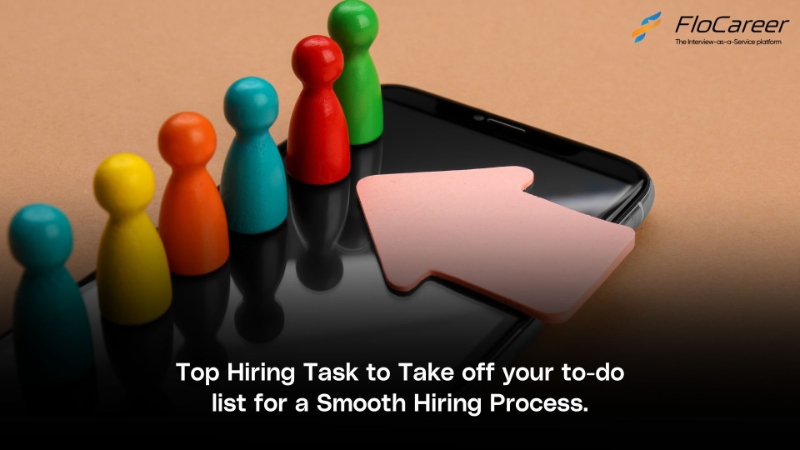Top Hiring Task to Take off your to-do list for a Smooth Hiring Process
In the realm of HR operations, where manual tasks can be both time-consuming and draining, envision a scenario where certain hiring responsibilities are permanently eliminated from your to-do list. Technological advancements have ushered in a new era of convenience, and this extends to the hiring process. Automated Hiring Platforms have become game-changers, revolutionizing everything from pre-screening to onboarding.

Read: A Comprehensive Guide for Efficient Interview Scheduling
Embracing the Hiring Revolution
The impact of technology on recruiting is undeniable. Recruiters now have unprecedented ease in identifying individuals with specific talents, while job seekers can proactively engage with employers. To optimize your hiring tasks, explore the potential of customized hiring platforms or recruiting platforms that can remove specific tasks, enhancing efficiency and conserving valuable time and resources.
Understanding the Hiring Process
The hiring process is a systematic approach to discovering, recruiting, and onboarding new personnel through a series of predefined steps. A robust hiring process plays a pivotal role in attracting and retaining high-quality employees. Common tasks in this process include reviewing applications, identifying candidates for interviews, conducting assessments, making hiring decisions, and performing pre-employment exams and checks.
Key Steps in the Hiring Recruitment Process
Step 1: Identifying Hiring Needs
Recognizing the organization's requirements is the first step. Understanding whether it's filling vacancies, optimizing team workloads, or expanding tasks is crucial.
Step 2: Developing a Recruitment Strategy
Creating a recruitment strategy involves linking new positions to organizational goals, communicating with internal teams, and aligning on the hiring process, steps, and criteria.
Step 3: Crafting a Position Description
Prioritizing job needs, the hiring team should formulate a comprehensive position description before proceeding.
Step 4: Promoting the Position
Publicizing vacancies on various platforms such as the company's website, social media, and job posting sites is essential.
Step 5: Recruiting for the Job
Proactively reaching out to potential candidates via platforms like LinkedIn and other social media enhances the chances of attracting ideal candidates.
Step 6: Reviewing Applications
Analyzing applications through established systems involves assessing various factors, with qualified applications moving on to the next stage.
Step 7: Initial Screening/Phone Interview
HR representatives typically conduct phone interviews to assess candidate suitability, values alignment, and cultural fit.
Step 8: Interviews
Inviting selected candidates for in-depth discussions about qualifications, experience, and skills.
Step 9: Applicant Evaluation
Post-interview assessments, including standardized tests, measure personality traits, abilities, reasoning, and other factors.
Step 10: Background Checks
Conducting background checks aligns with initial job posting requirements.
Step 11: Decision-making
Contacting references, conducting background checks, and selecting a top candidate precede the decision-making phase.
Step 12: Check References
Reference checks involve verifying relevant information about candidates' past employment, performance, and workplace conduct.
Step 13: Offer of Employment
Making an initial offer with detailed terms, negotiations, if any, specified.
Step 14: Hiring
Upon acceptance of the job offer, the applicant is officially hired, and necessary employment paperwork is completed.
Step 15: Onboarding
Welcoming the new employee, ensuring a smooth integration into the organization, providing orientation, and assigning a mentor for long-term success.
Read: The Power of Technical Interview Outsourcing
16. Utilize Video Interviews
Incorporate video interviews to streamline the initial screening process. Video interviews allow flexibility for both candidates and hiring teams, saving time and resources while providing a more personal touch to candidate interactions.
17. Implement Skill-based Challenges
Introduce practical, skill-based challenges that assess candidates' abilities in real-world scenarios. These challenges provide a tangible measure of their skills and help in identifying the most competent candidates for the job.
18. Embrace Diversity and Inclusion
Make diversity and inclusion a priority in your hiring process. Use blind recruitment techniques, focus on diverse candidate sourcing, and ensure that your hiring panels represent a variety of perspectives. This approach fosters innovation and contributes to a more dynamic work environment.
19. Enhance Candidate Experience
Invest in creating a positive candidate experience. From transparent communication about the hiring process to providing timely feedback, a positive candidate experience not only reflects well on your employer brand but also ensures a smoother hiring process.
20. Implement Continuous Feedback Loops
Establish a feedback loop with both candidates and the hiring team. Regularly seek input on the recruitment process, from application to onboarding, to identify areas for improvement. This continuous feedback loop contributes to an iterative and evolving hiring process.
21. Optimize Job Postings for Search Engines
Ensure your job postings are optimized for search engines. This increases the visibility of your job openings, attracting a broader pool of candidates. Utilize relevant keywords, clear job titles, and concise descriptions to enhance the discoverability of your positions.
22. Explore Niche Job Boards
Consider using niche job boards that cater specifically to your industry. This targeted approach can help you connect with candidates who possess specialized skills and are actively looking for opportunities in your field.
23. Invest in Employee Referral Programs
Tap into your existing employees' networks through referral programs. Employee referrals often result in high-quality candidates who are more likely to align with your company culture. Encourage and reward employees for referring suitable candidates.
24. Incorporate Soft Skills Assessment
While technical skills are crucial, don't overlook the importance of soft skills. Incorporate assessments or interview questions that evaluate candidates' communication, teamwork, and problem-solving abilities. A well-rounded skill set contributes to a candidate's success within the organization.
25. Utilize Chatbots for Initial Queries
Integrate chatbots into your recruitment process to handle initial queries from candidates. Chatbots can provide information about the company, the application process, and basic job details, freeing up valuable time for your recruitment team.
Streamlining Hiring Tasks with FloCareer
Now, let's delve into specific hiring tasks that can be seamlessly taken off your to-do list, allowing you to focus on strategic decisions and high-value activities.
1. Structured Interview Questions Creation
Crafting legally compliant, unbiased questions for each role can be time-consuming. FloCareer offers access to a comprehensive library of job-related questions vetted by Organisational Psychologists, ensuring compliance, fairness, and efficiency in evaluating candidates.
2. Interview Scheduling Streamlining
Interview scheduling often becomes a bottleneck, consuming time with back-and-forth communications. FloCareer Hiring Assistant puts candidates in control, offering a mobile-first, personalized experience, accelerating the time-to-hire.
3. Effective Pre-Screening for Interviews
Traditional methods may fall short in predicting job success. FloCareer suggests replacing outdated phone screens with skills-based assessments, improving the quality of candidate data collected and creating a unified, efficient experience.
4. Enhanced Candidate Follow-Up
Automated follow-up processes ensure consistent and constructive communication with candidates, improving candidate experience and making them more likely to consider the company for future opportunities.
Tools and Technologies for Enhanced Hiring
Incorporating technology is essential for an efficient hiring process. Trending tools and technologies include:
Artificial Intelligence (AI): Enhances hiring efficiency by automating tasks like identifying prospects in the Applicant Tracking System (ATS).
Social Media: Platforms like Twitter, TikTok, LinkedIn, and Quora offer diverse channels for outreach, facilitating efficient candidate engagement.
Job Descriptions Formation Tools: Assess the quality of job descriptions, considering factors like readability and searchability.
Applicant Tracking Software (ATS): A foundational technology to manage candidate information efficiently.
Candidate CRM: Establishes a talent pool, allowing candidates to self-select for specific positions and enabling a more personalized approach.
Embracing Efficiency with FloCareer
Leveraging technology is key to a swift and efficient hiring process. FloCareer, your Ethical Hiring Platform, promises to assist you in efficiently managing and optimizing your hiring tasks. By incorporating innovative methods and tools like FloCareer, organizations can modernize their talent acquisition strategies and engage with prospects in novel ways, ensuring a well-balanced and efficient recruitment process.
Read: The Transformative Power of Flocareer's Technical Interview Outsourcing Service


